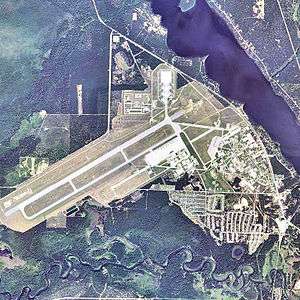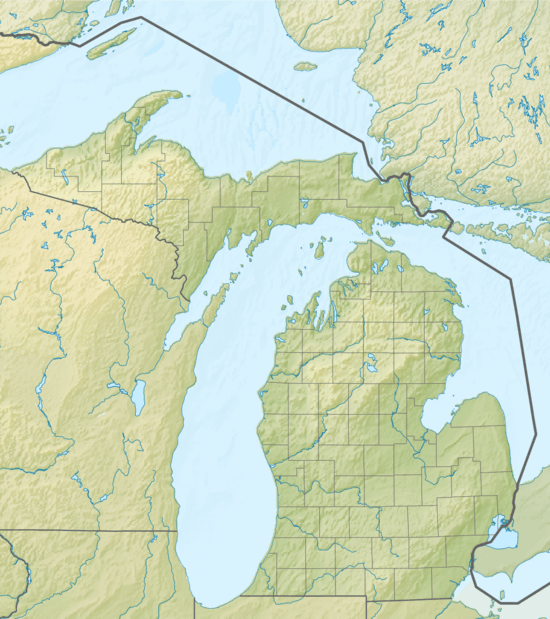Oscoda–Wurtsmith Airport
Oscoda–Wurtsmith Airport (IATA: OSC, ICAO: KOSC, FAA LID: OSC) is a public use airport located three nautical miles (6 km) northwest of the central business district of Oscoda, an unincorporated community in Iosco County, Michigan, United States. It is owned by the Oscoda–Wurtsmith Airport Authority.[1] It is included in the Federal Aviation Administration (FAA) National Plan of Integrated Airport Systems for 2017–2021, in which it is categorized as a local general aviation facility.[2]
Oscoda–Wurtsmith Airport | |||||||||||
|---|---|---|---|---|---|---|---|---|---|---|---|
 USGS 2006 Airphoto | |||||||||||
| Summary | |||||||||||
| Airport type | Public | ||||||||||
| Owner | Oscoda–Wurtsmith Airport Authority | ||||||||||
| Serves | Oscoda, Michigan | ||||||||||
| Elevation AMSL | 634 ft / 193 m | ||||||||||
| Coordinates | 44°27′06″N 083°23′39″W | ||||||||||
| Map | |||||||||||
 OSC Location of airport in Michigan  OSC OSC (the United States) | |||||||||||
| Runways | |||||||||||
| |||||||||||
| Statistics | |||||||||||
| |||||||||||
It was built out of a portion of the decommissioned Wurtsmith Air Force Base which housed nuclear armed B-52 Stratofortress bombers during the Cold War as well as air refueling squadrons.
Oscoda–Wurtsmith Airport became a public airport in 1993. It is primarily a cargo and light general aviation airport with no scheduled passenger services.
The Wurtsmith Base Conversion Authority terminated in 1994, when the Charter Township of Oscoda took over as the Redevelopment Authority. The Authority was organized under Michigan Public Act 206 of 1957. It has five municipal constituents; Oscoda Township, AuSable Township, Greenbush Township, Iosco County and Alcona County. The purpose of the Authority is generally to operate and maintain a public airport. The Michigan Legislature created the Wurtsmith Renaissance Zone in 1997, which exempted businesses and residents of the 5,000 acre (20 km²) zone from all state and most local taxes.
It now occupies a portion of the former base and is primarily used for cargo and light general aviation activities. There is no scheduled passenger service. The Airport offers 24-hour near all weather daily access. Its UNICOM frequency is 123.0 MHz.[3]
Facilities and aircraft
Oscoda–Wurtsmith Airport covers an area of 2,000 acres (810 ha) at an elevation of 634 feet (193 m) above mean sea level. It has one asphalt paved runway designated 7/25 which measures 11,800 by 200 feet (3,597 by 61 m).[1]
For the 12-month period ending December 31, 2005, the airport had 8,857 aircraft operations, an average of 24 per day, all of which were general aviation. In November 2016, there were 24 aircraft based at this airport: 13 single-engine, 8 jet, 2 helicopter and 1 glider.[1]
Of note is the operations of the Yankee Air Force Museum – Wurtsmith Division.[4] Periodic events are held by them.
Kalitta Air has a large maintenance operation at the airport.[5]
Other tenants at the former base include the Aune Medical Center, Alcona Health Center Dental Clinic, Alpena Community College, Comprehensive Aviation Training, and numerous private businesses. The former military housing units have been refurbished by the Village of Oscoda, and now serve as a major population base in the Oscoda area. Another portion of the former base houses a community center.
Environmental concerns
On 18 January 1994, the Environmental Protection Agency proposed to add Wurtsmith Air Force Base to the National Priorities List making the base a Superfund site. Discovery of groundwater contaminated with metals, polycyclic aromatic hydrocarbons, and volatile organic compounds, including trichloroethylene, 1,1-dichloroethane, 1,1,1-trichloroethane, and vinyl chloridebon the base drove the proposal.[6] Knowledge of the contaminated soil and groundwater existed since 1977, and cleanup efforts began before the Superfund program was created. In 1999 and 2001, Soil vapor extraction systems were added to remove the volatile organic compounds from the site. Since 2004, bioventing and biosparging systems have been cleaning soil and groundwater.[7]
Wurtsmith was proposed but never formally added to the federal Superfund program.[8] In 2010, PFC contamination was discovered. There is a "do not eat" advisory for all non-migratory fish caught from Clark's Marsh and the lower Au Sable River south of the former base. Wurtsmith is one of 200 military installations around the world that did or still use PFC-laden Aqueous Film Forming Foam (AFFF).[8]
See also
References
- FAA Airport Master Record for OSC (Form 5010 PDF), effective Nov 10, 2016.
- "List of NPIAS Airports" (PDF). FAA.gov. Federal Aviation Administration. 21 October 2016. Retrieved 25 November 2016.
- "About Oscoda–Wurtsmith Airport". Archived from the original on 2008-03-27. Retrieved 2007-12-06.
- Yankee Air Force Museum, Wurtsmith Division
- "Home - Oscada Airport". Retrieved 24 November 2017.
- "Wurtsmith Air Force Base Superfund sites progress profile". EPA. Retrieved 21 February 2010.
- "Wurtsmith Air Force Base Superfund site description". EPA. Retrieved 22 February 2010.
- Garret Ellison (20 May 2016). "Toxic water near old Michigan Air Force base prompts new scrutiny". MLive Media Group. Retrieved 25 May 2016.
External links
- FAA Terminal Procedures for OSC, effective July 16, 2020
- Resources for this airport:
- FAA airport information for OSC
- AirNav airport information for KOSC
- ASN accident history for OSC
- FlightAware airport information and live flight tracker
- NOAA/NWS weather observations: current, past three days
- SkyVector aeronautical chart, Terminal Procedures